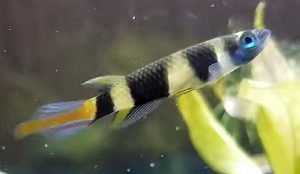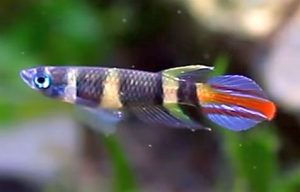The Clown Killifish (Pseudepiplatys annulatus) also known to tropical fish keeping enthusiasts as the Rocket Killie, Banded Panchax, or Clown Killie is a miniature non-annual species found in the slow moving streams in the swamps, savannas, and tropical rain forests of southern Guinea, Liberia, and Sierra Leone,in West Africa.
In the wild, Pseudepiplatys annulatus or Epiplatys annulatus are found in very shallow warm, soft, acidic, slow moving water of their range, among aquatic plants and heavy marginal vegetation that they use for cover.
The Clown Killifish resembles a miniature pike.
They have an elongated, torpedo shaped body with an upturned mouth and round heads.
The dorsal fin begins just before the end of the anal fin and ends rather far back on the body. They have a spade shaped caudal fin with elongated central rays in adult fish. In males, the rays can be as long as the rest of the caudal rays.
Although there are several wild strains of Clown Killifish available to tropical fish keeping enthusiasts, those from Monrovia, Liberia (Pseudepiplatys annulatus monroviae) are generally regarded as the most colorful.
Except for some variations, Clown Killifish are cream colored, with four wide, vertical, black bands along the flanks that start just behind the head, and bright spot on top of the head between the eyes.
The dorsal fin in male specimens can be cream, light red, or a bright blue/with red. The caudal fin in males varies, but is generally pale to sky blue, with the extended middle rays being bright red.
The bright red in some variations can be light orange, yellowish with bright red lines above and below, or even bright blue outlined in red, with bright yellow tips on the extensions.
Depending on the variant, the anal fin in males can be blue, blue outlined in red, fright red, or red outlined in blue. Likewise, the ventral fin can be either clear, a bright red, a bright orange, or a pale red color.
Female Clown Killifish are slightly smaller, less colorful, and have less developed fin extensions than males. Most females have clear dorsal fins, clear caudal fins with faint orange, red, yellow colored extended rays throughout their length, and anal and ventral fins that are not always clear.
Clown Killifish are small and seldom grow larger than 1.4 inches in length, which makes them a great choice for smaller micro or nano aquarium setups. They do best in small groups of 1 male to 3 females, 2 males to 6 females, etc. especially if breeding is anticipated.
The Clown Killifish can be kept in a densely planted nano or micro aquarium with a sand or very fine substrate, a small piece of driftwood, and some Indian Almond
or other dried leaf litter on the bottom.
Fine leaved plants like Java Moss, Cabomba
, Riccia
, etc. are recommended, as are floating plants like Water Lettuce, Salvinia, or Lemna
. The floating plants reduce overhead light in the tank, provide a place for the fry to hide, act as a natural filtration system for the water, and are a source of micro foods for both adults and fry. The addition of Indian Almond Leaves
, alder cones, or dried leaf litter provides cover for the fish and as decomposition occurs, promotes the growth of beneficial microbe colonies that insure the health of the adults, the eggs, and the fry.
Pseudepiplatys annulatus are sensitive to deteriorating water conditions and should never be introduced into biologically immature systems. They need clean, well filtered water, but do not necessarily need an outside filtration system if 50% weekly water changes are performed.
Clown Killifish are egg scatterers that are quite easy to breed. In a well decorated, biologically mature aquarium, the fry will usually materialize without human intervention, provided larger invertebrates such as snails or shrimp are not present in the breeding tank, as they will eat the eggs.
To save more fry, place two to three pairs into a breeding tank as described above and remove the medium in the tank every few days to a rearing tank for incubating and hatching. Courting males will exhibit some harmless belligerance toward each other until spawining takes place and eggs are deposited.
The extremely small eggs will hatch out in 10 to 14 days at a temperature of 75 to 77 degrees. The fry are extremely small and will initially feed on the natural production of microbes from leaf decomposition. Add green water supplemented with infusoria to the rearing tank to help with initial growth. After 3 or 4 days, three or four days, they should be large enough to eat Paramecium and young nematodes. When the fry can be seen swimming on the surface hunting, feed them Vinegar eels or microworms
until they are able to eat adult foods.
Adult Clown Killifish require live foods such as white worms, daphnia, brine shrimp
, small bloodworms, and tubifex. Vary their diet to keep them healthy.
Clown Killifish (Pseudepiplatys annulatus) are rarely available in tropical fish keeping shops but can be procured online from specialty dealers and Killifish societies at moderate prices.
Care Level: Moderate
Temperament: Peaceful, Shy
Hardiness: Hardy
Water Conditions: 73° – 78°F, 0 – 5 dGH, pH 5.5-6.5
Max. Size: 1.4”
Color Form: Gold, Brown, Orange
Diet: Carnivore
Compatibility: Biotope nano and micro tanks
Origin: West Africa
Family: Nothobranchiidae
Lifespan: 3-5 years
Aquarist Experience Level: Experienced





